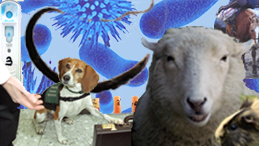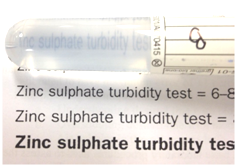
ANSC20003 Topics in Animal Health
Prac 2: Diagnostic Tests
Prac 2: Diagnostic Tests

Zinc Sulphate Turbidity Test
The zinc sulphate turbidity test assesses the approximate concentration of IgG in serum or plasma to establish the immune status of foals.The test uses 8 ml aliquots of zinc sulphate solution that have been prepared in 10mL plain collection tubes. It has been prepared by adding 250 mg ZnSO4.7H2O in 1 L freshly boiled water (to remove CO2). When large protein molecules (e.g. IgG) are added, the zinc sulphate comes out of solution and makes the liquid turbid (“cloudy”).
The cost of this test is approximately $3.
Procedure
- Label the four tubes: A, B, C, D
- Extract a 0.15 mL (150µl) sample of each of the plasmas (A, B, C, D) with a blue pipette (note: you could use a 1 mL insulin syringe and needle in the field) and add it to the labelled tube. Repeat for the other three plasmas
- Mix by inverting the tube twenty times and start the clock (there is a timer on the iPad).
- Wait 10 min and check if there is turbidity (qualitative test).
- Wait 60 min and measure against the calibrated ‘printing test’.
- Record your results in Table 1. This will be a range of values (semi-quantitative test).
Interpretation
Obvious turbidity developed in 10 min means there is adequate immunoglobulin content.Observe the tube after 60 minutes. Lie the tube against the writing below starting with the lowest font first and then slide it down to the highest. If you can read the print CLEARLY (it would be easy to read the text without any difficulty) through the full thickness of the zinc sulphate solution tube, the globulin level is as indicated opposite to each size of print.

Measuring the turbidity with a Zn SO4 tube